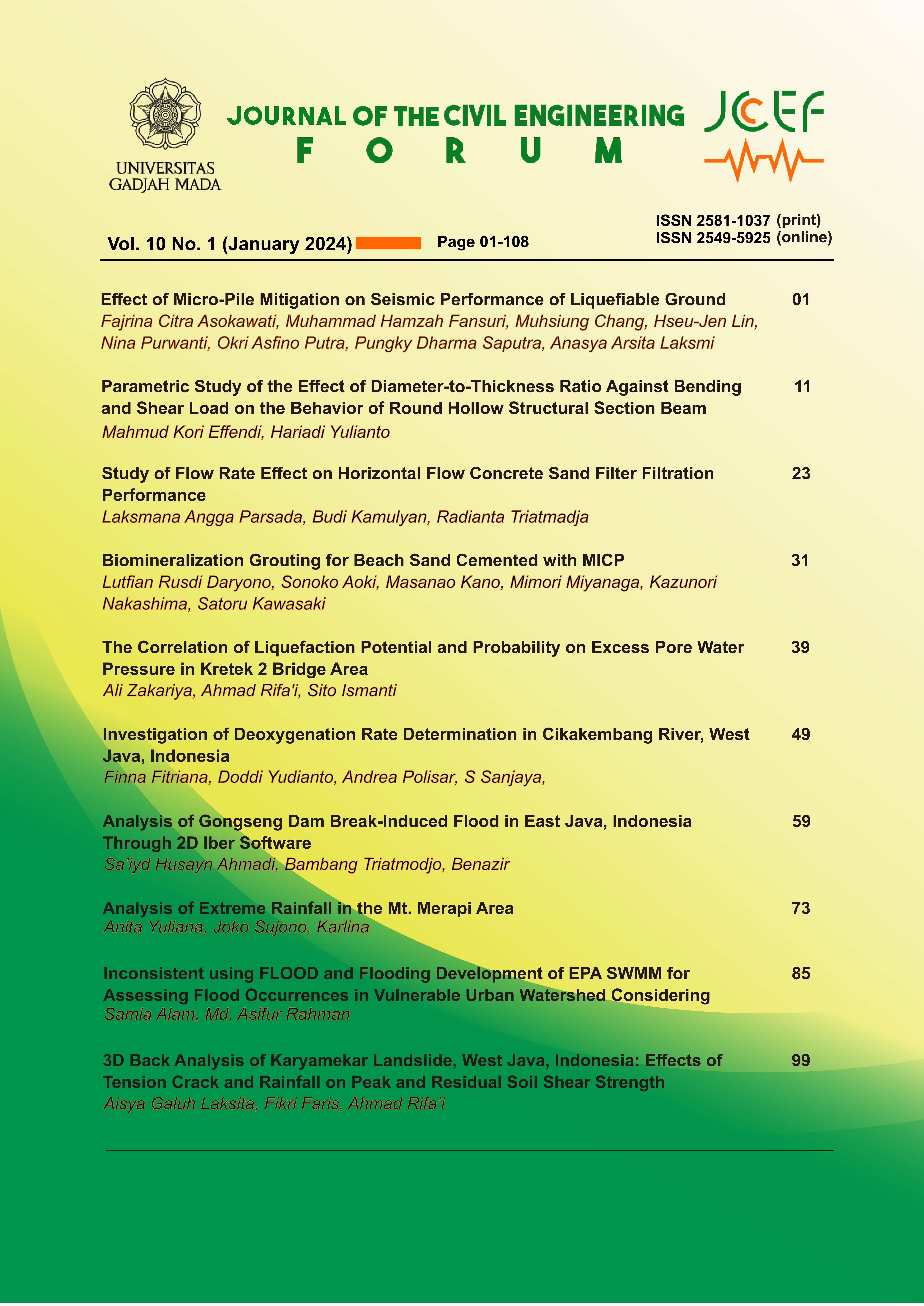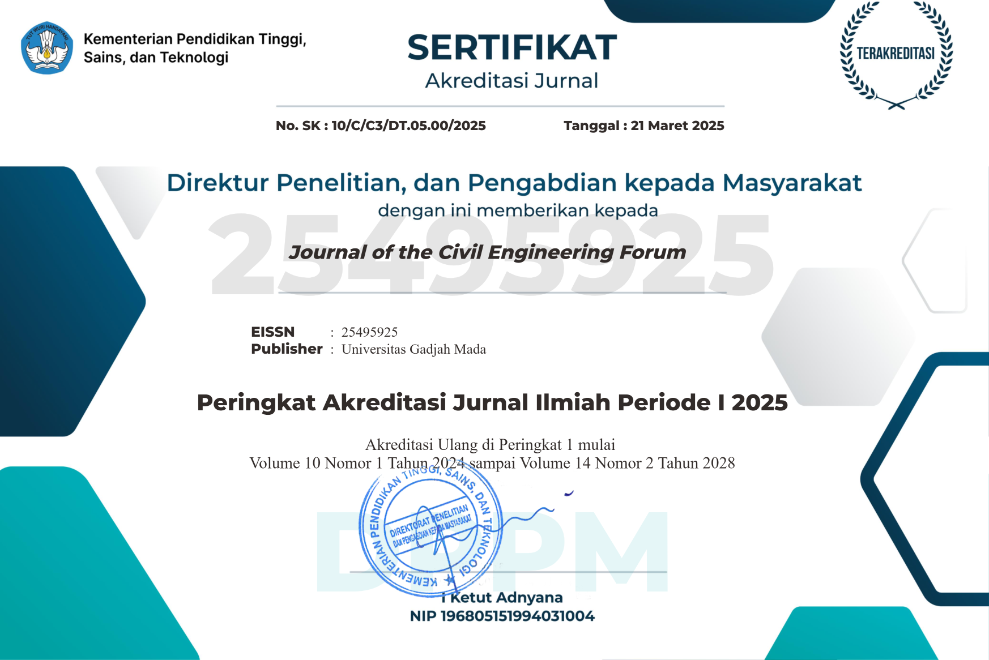Study of Flow Rate Effect on Horizontal Flow Concrete Sand Filter Filtration Performance
Abstract
The need for clean water during the pandemic is significantly increasing due to high public awareness of adopting a clean and healthy lifestyle (PHBS), necessitating more water treatment. Conventional methods are used for water treatment, including coagulation-flocculation system, rapid sand filter, and disinfection. However, these methods have limitations such as reduced capacity and sand filter efficiency, leading to increased backwash costs due to the need for sand replacement caused by particle stratification. In response to these challenges, an innovative method to water treatment is the use of concrete sand filter (CSF). Previous studies predominantly focused on downflow filtration, but there has been limited analysis of horizontal flow. Therefore, this study aimed to assess filtration and backwash effectiveness of CSF with horizontal flow, specifically focusing on the capacity performance in treating water with varying levels of turbidity. Filtration experiment was carried out using simulated water at turbidity of 125 NTU based on the Mataram Channel Turbidity with variations of 0.2, 0.5, 1.0, 5.0, and 10.0 m hour-1, as well as backwash at flow rate of 40.91 m hour-1 for 3 minutes. The variables measured during filtration process included head losses and turbidity at the inlet and outlet of CSF. The results showed that the capacity performance during filtration process was directly proportional to flow rate. Meanwhile, the effectiveness of concrete filter was inversely proportional to flow rate. At initial turbidity <617 NTU, the 3 minutes backwash process obtained lower final turbidity compared to the raw water used, which was 5.19 NTU. Meanwhile, at turbidity 617 NTU, the final turbidity was still high, reaching approximately 14.6–26.4 NTU.
References
AWWA B100-16: Granular Filter Material (2016), New York. https://doi.org/10.12999/AWWA.B100.16.
Badan Pusat Statistik Indonesia (2020), ‘Statistik air bersih 2015 - 2020’.
CNN Indonesia (2021), ‘Studi: Konsumsi air bersih naik 3 kali lipat saat pandemi’. https://www.cnnindonesia.com/ekonomi/20210211175246-92-605397/studi-konsumsi-air-bersih-naik-3-kali-lipat-saat-pandemi.
Crittenden, J., Trussell, R., Hand, D., Howe, K. and Tchobanoglous, G. (2012), MWH’s Water Treatment - Principles and Design, 3rd edn, John Wiley & Sons, Inc., New Jersey.
Davies, P. (2012), ‘Alternative filter media in rapid gravity filtration of potable water’.
Droste, R. and Gehr, R. (2019), Theory and Practice of Water and Wastewater Treatment, 2nd edn, John Wiley & Sons, Inc., New Jersey.
Encyclopædia Britannica Inc. (2008), Universe, in ‘Britannica Illustrated Science Library’, Encyclopædia Britannica, Inc.
Hasan, H., Al-Baidhani, J. and Al-Saadi, R. (2020), ‘Evaluating the effects of the flow direction on the performance of the rapid sand filter’, IOP Conference Series: Materials Science and Engineering 928(2).
Kamulyan, B. (2014), ‘Karakteristik hidraulik filtrasi dan cucibalik filter beton’.
Kamulyan, B., Nurrochmad, F., Triatmadja, R. and Sunjoto, S. (2009), Capacity of concrete sand filter to treat high turbid water, in ‘International Conference on Sustainable Development for Water and Wastewater Treatment’, Universitas Gadjah Mada, Yogyakarta. https://opac.perpusnas.go.id/DetailOpac.aspx?id=45451.
Khelladi, R., Fellah, A., Pontié, M. and Guellil, F. (2020), ‘Influence of particle and grain size on sand filtration: Effect on head loss and turbidity’, Aquatic Science and Technology 8(2), 36.
Mahanna, H., Radwan, K., Fouad, M. and Elgamal, H. (2018), ‘Effect of operational conditions on performance of deep sand filter in turbidity removal’, Trends in Technical & Scientific Research 02(5).
Rehder, B., Banh, K. and Neithalath, N. (2014), ‘Fracture behavior of pervious concretes: The effects of pore structure and fibers’, Engineering Fracture Mechanics 118, 1–16.
Said, N. and Yudo, S. (2008), Bab 3 – masalah dan strategi penyediaan air bersih di indonesia, in ‘Teknologi Pengolahan Air Minum ’Teori dan Pengalaman Praktis”, p. 80–106.
Sendekie, Z. and Bacchin, P. (2016), ‘Colloidal jamming dynamics in microchannel bottlenecks’, Langmuir 32(6), 1478–1488.
Yao, K., Habibian, M. and O’Melia, C. (1971), ‘Water and waste water filtration: Concepts and applications’, Environmental Science and Technology 5(11), 1105–1112.
Copyright (c) 2024 The Author(s)

This work is licensed under a Creative Commons Attribution-ShareAlike 4.0 International License.
Copyright is granted to authors for the purpose of providing protection for articles written to describe experiments and their results. JCEF will protect and defend the work and reputation of the author and are also willing to address any allegations of violation, plagiarism, fraud, etc. against articles written and published by JCEF. JCEF is published under the terms of the Creative Commons Attribution-ShareAlike 4.0 International License (CC BY-SA 4.0). The author holds the copyright and assigns the journal rights to the first publication (online and print) of the work simultaneously.







